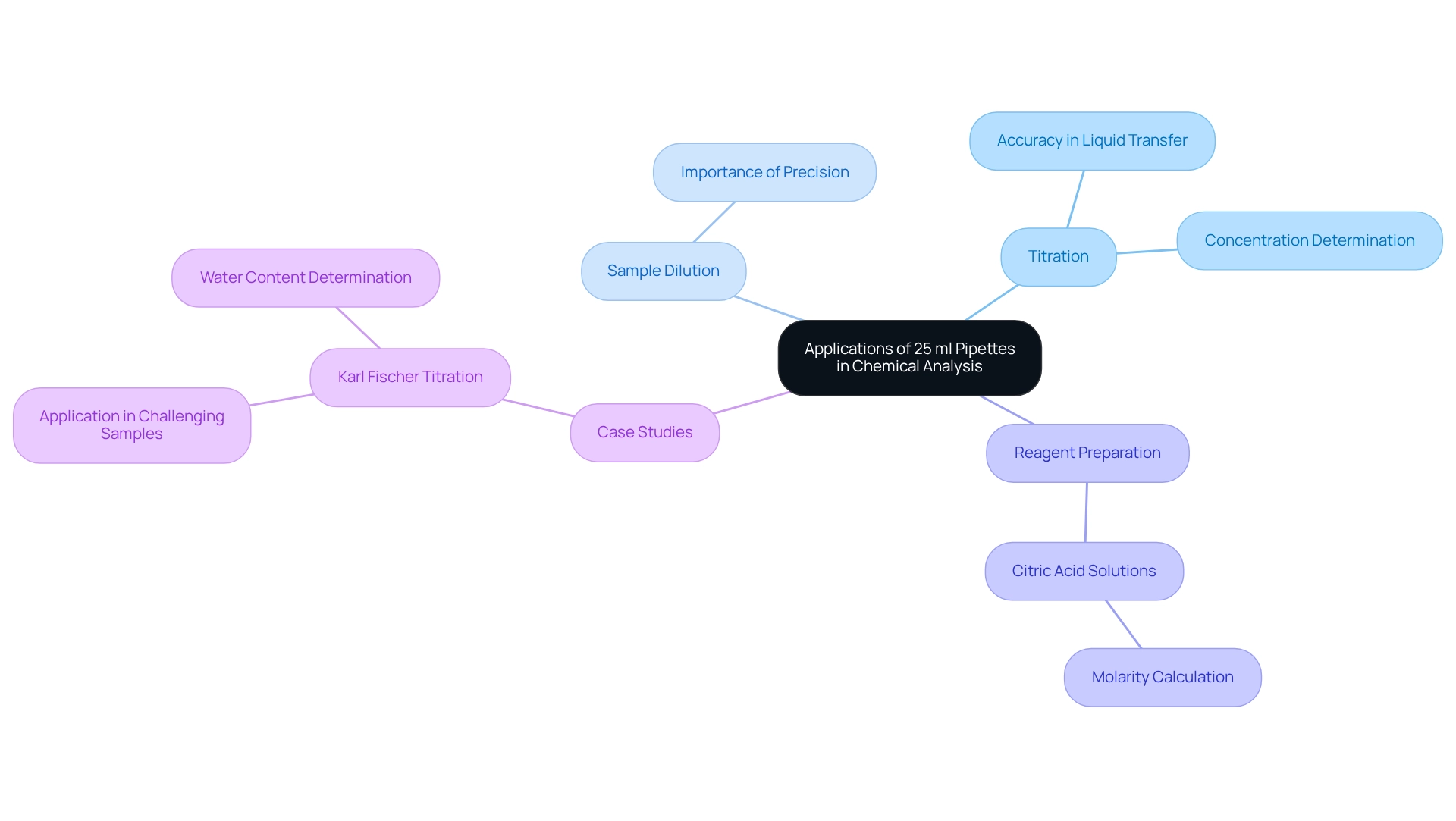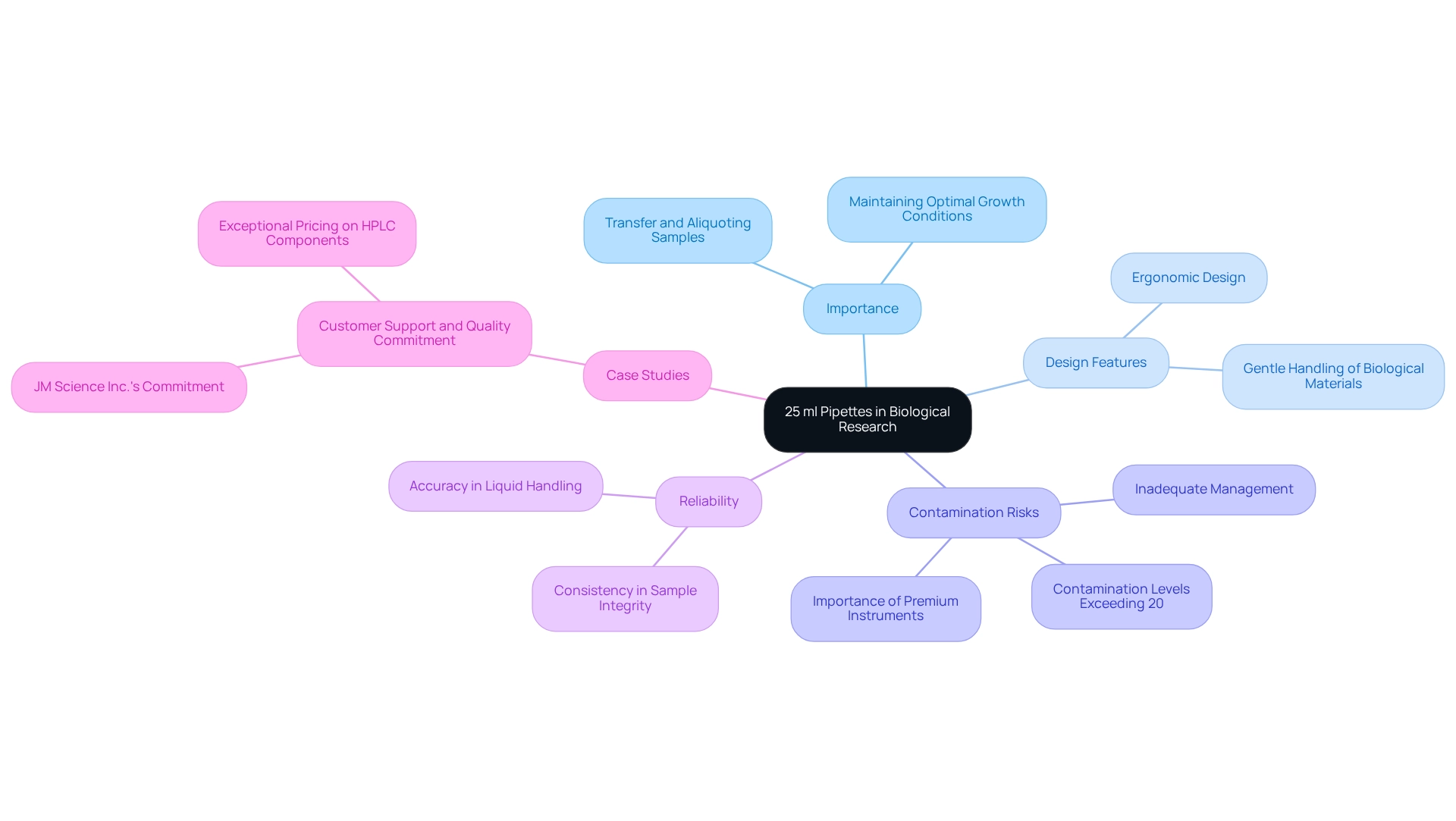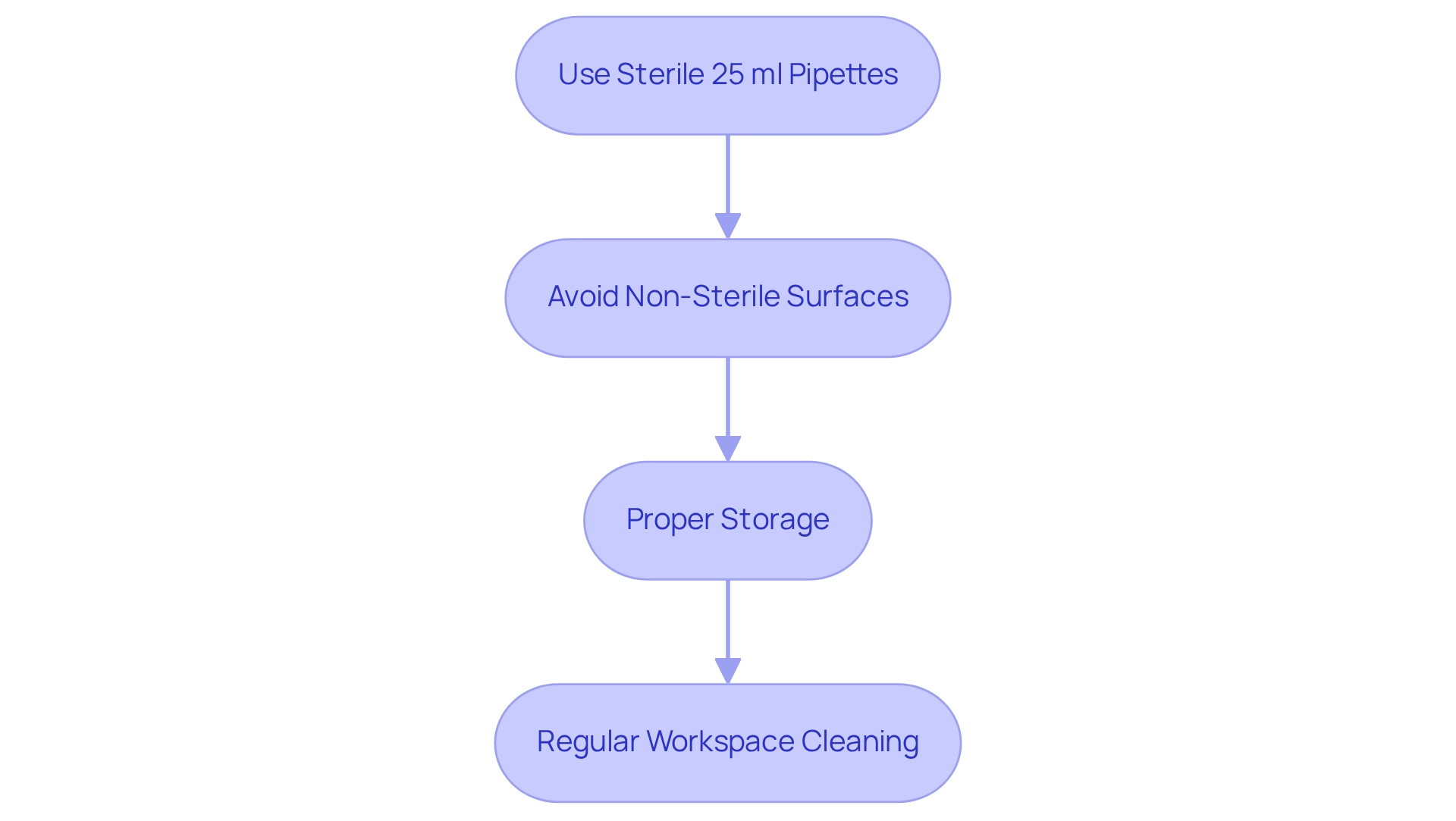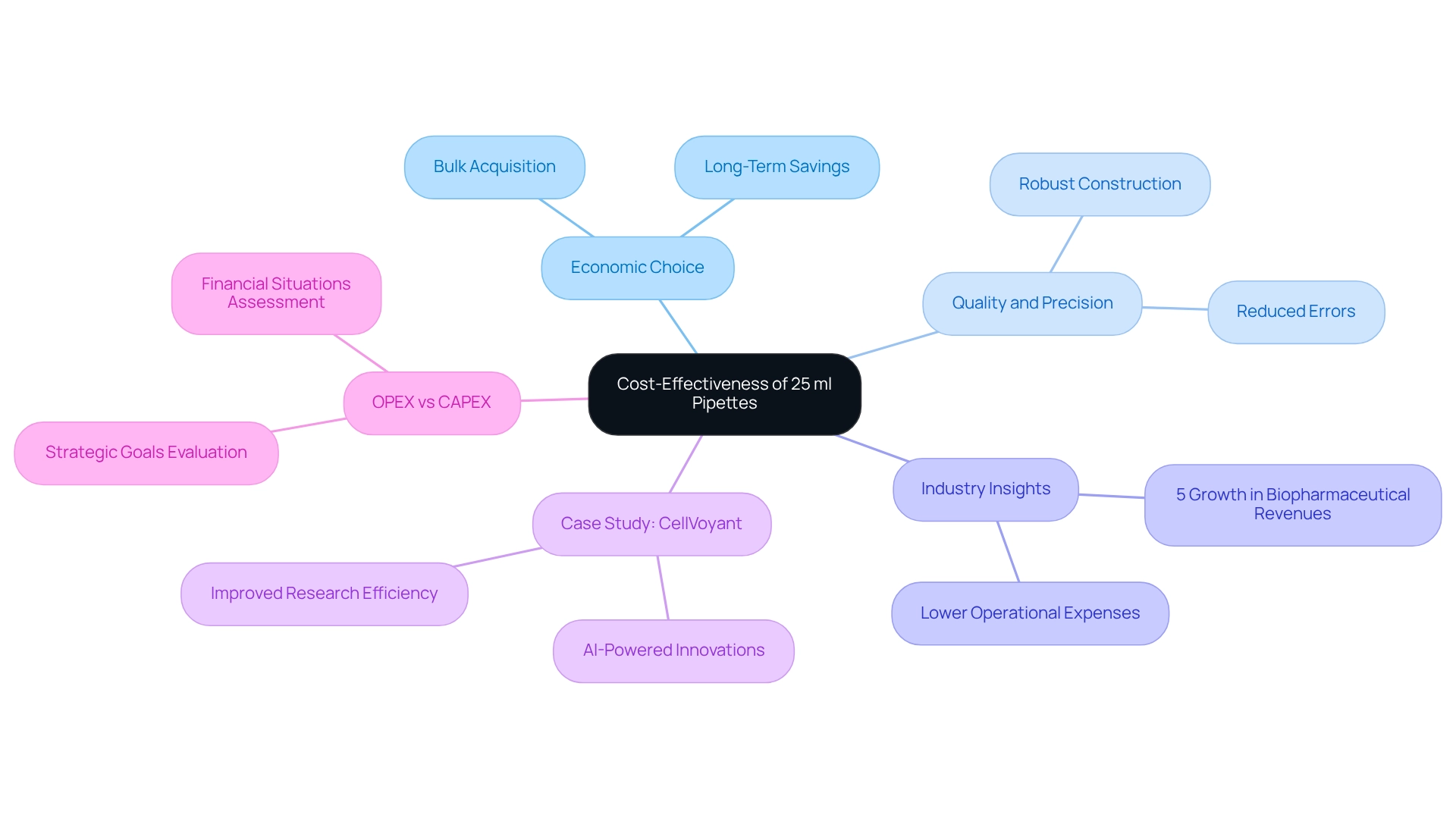Overview
This article delves into the essential applications of 25 ml pipettes within pharmaceutical laboratories, underscoring their critical role in ensuring precise measurements across various applications, including:
- Drug formulation
- Quality control
- Biological sample handling
Accuracy in liquid transfer is not merely beneficial; it is vital for maintaining the integrity of experiments and adhering to industry standards. This focus on precision ultimately emphasizes the pipettes' significance in achieving reliable and reproducible research outcomes. By understanding the indispensable nature of these instruments, laboratories can enhance their operational efficiency and uphold the highest standards of scientific inquiry.
Introduction
In the realm of scientific research and pharmaceutical development, precision is not merely a goal; it is an absolute necessity. The 25 ml pipette from JM Science emerges as an essential tool that embodies this principle, empowering laboratory technicians to achieve unmatched accuracy in liquid measurement and transfer.
With meticulously graduated markings, this pipette plays a pivotal role in ensuring that even the most minute variations are accounted for—critical in high-stakes environments like pharmaceutical labs, where the integrity of research can hinge on precise measurements.
As laboratory practices evolve, the versatility and reliability of 25 ml pipettes become increasingly evident, impacting a wide array of applications, from drug formulation to biological sample handling.
This article delves into the multifaceted significance of 25 ml pipettes, exploring their essential roles across various scientific disciplines and highlighting the innovations that continue to shape their use in modern laboratories.
JM Science 25 ml Pipettes: Precision for Accurate Measurements
The 25 ml pipettes from JM Science stand out for their outstanding accuracy, empowering laboratory technicians to measure and transfer substances with minimal error. This precision is crucial in pharmaceutical labs, where even minor deviations can significantly impact research outcomes. The graduated markings on the pipette are essential for accurately gauging volume, particularly in applications such as drug formulation and quality control testing. Advanced techniques like Karl Fischer titration for moisture analysis in pharmaceuticals demand this level of precision, as the reliability of evaluations directly influences adherence to regulations like the Japanese Pharmacopoeia.
Industry standards underscore the importance of graduated markings on liquid accuracy; they ensure that each transfer is both precise and repeatable. Moreover, expert opinions emphasize that accurate pipetting is fundamental to maintaining the integrity of pharmaceutical research. MicronPA notes, 'A lack of impact analysis could lead to defective testing instruments, which could become expensive concerning safety and efficiency.' This statement highlights the significance of dependable assessment tools in achieving successful results.
Recent studies further indicate that precision measurement tools can reduce errors by up to 30%, reinforcing the critical role of accurate pipetting in pharmaceutical labs. In summary, the 25 ml pipettes from JM Science are not just tools; they are vital instruments in the quest for excellence in pharmaceutical research.
Versatile Applications of 25 ml Pipettes in Chemical Analysis
25 ml pipettes are essential instruments in chemical analysis, particularly in titration, sample dilution, and reagent preparation. Their precision in delivering exact volumes is critical for preparing standard solutions and conducting quantitative analyses. In titration processes, for instance, accurate liquid transfer is vital for determining the concentration of unknown solutions. This precision is underscored by the reality that even minor variations in volume can significantly impact results, establishing the 25 ml pipettes as an indispensable tool in analytical chemistry laboratories.
The versatility of 25 ml pipettes spans various applications, such as the preparation of citric acid solutions. A specific molarity of 0.0322 M can be achieved through meticulous measurements using 25 ml pipettes, highlighting their importance in ensuring precise solution preparation. Furthermore, expert insights emphasize the role of these instruments in achieving reliable outcomes in chemical analysis. As noted by Randy Travis, technologist of the Department of Chemical, Environmental, and Biotechnology at Mohawk College, "the ability to transfer liquids accurately is foundational to successful analytical outcomes."
Real-world applications of 25 ml pipettes are evident in case studies, such as their utilization in Karl Fischer titration techniques. In these scenarios, 25 ml pipettes facilitate the precise measurement of water content in challenging samples, especially when analyzing materials that require specific conditions for effective measurement. Continuous advancements in liquid handling technology and methodologies further enhance their utility, ensuring that laboratories can maintain high standards of precision and reliability in their analyses.

Utilizing 25 ml Pipettes for Biological Sample Handling
In biological research, 25 ml pipettes are indispensable for the transfer and aliquoting of samples, which include blood, serum, and cell cultures. Their ergonomic design allows for the gentle handling of sensitive biological materials, significantly reducing the risk of contamination and degradation.
For example, precise liquid handling in cell culture preparation is vital for maintaining optimal growth conditions. Research indicates that inadequate management can lead to contamination levels exceeding 20%, particularly when lower-quality instruments are employed. This underscores the importance of selecting premium alternatives, such as those offered by JM Science Inc.
The 25 ml pipettes are frequently favored among life sciences researchers for their accuracy and reliability, which are both crucial for successful experimental outcomes. Furthermore, case studies reveal that laboratories using 25 ml pipettes experience enhanced consistency in sample integrity, further validating the role of 25 ml pipettes in biological sample handling.
JM Science Inc.'s commitment to excellence and client support, as highlighted in the case study 'Customer Support and Quality Commitment,' reinforces the confidence researchers can place in their instruments, ensuring compliance with the stringent requirements of biological research.

Essential Role of 25 ml Pipettes in Pharmaceutical Development
In the realm of pharmaceutical advancement, 25 ml pipettes play a pivotal role in accurately gauging and blending compounds during drug formulation. Their precision is essential, as it guarantees that active ingredients are combined in the correct proportions, which is critical for achieving the desired therapeutic effects. For example, during stability testing, meticulous handling of substances is vital to assess how formulations behave over time, which makes the use of 25 ml pipettes integral to the development process.
The importance of accurate measurements in drug formulation cannot be overstated. Pharmaceutical researchers emphasize that even minor discrepancies in fluid handling can lead to significant variations in drug efficacy and safety. This is particularly evident in automated processes, such as those employed in minimum inhibitory concentration (MIC) testing for antibiotic development, where automated pipetting systems enhance productivity and ensure consistent results. Such advancements empower lab personnel to concentrate on other essential tasks, thereby improving overall workflow efficiency.
The Acura® manual liquid transfer line is engineered for both delicate research and routine applications, offering versatility across various laboratory settings. As German physician Heinrich Schnitger remarked, "This allowed operators to accurately aspirate and dispense extremely small volumes of fluid," underscoring the necessity of precision in substance handling.
Statistics indicate that the compound annual growth rate (CAGR) for disposable transfer tips is projected at 9.5%, highlighting the increasing reliance on accurate liquid handling in pharmaceutical laboratories. This trend underscores the growing significance of precision instruments in ensuring drug formulation accuracy, as they are indispensable tools for obtaining reliable and reproducible results in research and development. The expansion in the market for single-use tips illustrates how critical precise liquid handling has become in guaranteeing the quality and safety of pharmaceutical products.
In conclusion, the role of 25 ml pipettes in pharmaceutical development is indispensable, not only for ensuring precise quantities but also for facilitating the intricate procedures involved in drug formulation. Their application is bolstered by a wealth of expert insights and case studies that illustrate their impact on the pharmaceutical industry, including the challenges posed by manual pipetting that automation aims to resolve.

Ensuring Quality Control with 25 ml Pipettes in Laboratories
Quality assurance in testing facilities fundamentally relies on accurate measurements, with 25 ml pipettes serving as vital instruments in this context. These dispensers enable consistent and precise transfers of fluids, which are essential for producing dependable experimental data. As laboratories increasingly engage with reduced fluid volumes and more complex multipart tests, the role of 25 ml pipettes becomes even more critical in ensuring data integrity and adherence to stringent quality control standards.
Regular calibration and maintenance of 25 ml pipettes are imperative to uphold quality standards; neglecting these practices can lead to significant discrepancies in results. Utilizing high-quality pipettes from JM Science not only enhances measurement accuracy but also strengthens overall quality control protocols. JM Science offers a variety of high-quality scientific instruments, including Karl Fischer reagents, HPLC columns, and titrators, which further improve accurate handling and analysis in pharmaceutical laboratories.
Furthermore, to minimize the risk of liquid handling inaccuracies and enhance data integrity, training programs focused on pipetting techniques are essential. The impact of precision in liquid handling extends beyond individual experiments, affecting the trustworthiness of experimental data and ultimately influencing research outcomes. Case studies on quality control methods utilizing 25 ml pipettes further illustrate the significance of appropriate pipette usage and maintenance in achieving reliable research findings. Explore JM Science's product range to enhance your facility's quality control solutions.
Teaching Laboratory Techniques with 25 ml Pipettes in Education
25 ml droppers serve as invaluable tools for teaching laboratory techniques in educational environments. Their intuitive design and accuracy make them ideal for demonstrating fundamental skills such as liquid quantification and transfer. Instructors can effectively leverage these tools to underscore the critical importance of accuracy in scientific experiments, thereby establishing a solid foundation for students' future careers in science and research.
For instance, recent assessments reported values of 2.02 and 2.01 milligrams for the same 5 milligrams of substance, underscoring the significance of precision in scientific evaluations. Practical training with these tools not only enhances students' hands-on abilities but also highlights the importance of accurate data in achieving reliable research outcomes.
As Mary wisely stated, "Every time you take a reading, it may be somewhat different from the others, but by taking numerous readings, you will gain a clearer understanding of the actual value of the quantity you are attempting to assess."
Educational programs that utilize 25 ml pipettes have shown significant enhancements in students' understanding of liquid handling techniques, fostering a greater appreciation for the meticulous nature of scientific work.
As emphasized in the case study titled 'Impact of Assessment on Scientific Research,' rigorous evaluation practices are essential for advancing scientific knowledge and ensuring the integrity of experimental results. Furthermore, the clear communication of values in scientific measurements is crucial, as it underpins the reliability of the data collected and the conclusions drawn from it.

Ergonomic Design Benefits of 25 ml Pipettes for Lab Technicians
The ergonomic design of 25 ml pipettes from JM Science significantly enhances comfort for lab technicians during extended use. These liquid handling devices feature a lightweight design and shaped grips, effectively reducing hand fatigue and decreasing the likelihood of repetitive strain injuries.
Furthermore, Sartorius tip containers are provided in racks that can be opened with one hand, facilitating ease of use in the research environment. Research indicates that ergonomic tools can lead to a 20% increase in productivity, as technicians experience less discomfort and can concentrate more on their tasks.
By prioritizing ergonomic design, research facilities not only enhance the well-being of their personnel but also foster a more efficient work environment. Case studies have shown that introducing ergonomic instruments like 25 ml pipettes can decrease hand fatigue by as much as 30%, enabling technicians to perform their tasks with enhanced comfort and accuracy.
Insights from the case study titled 'Strategies for Mitigating Ergonomic Risks' underscore the importance of ergonomic tools in reducing musculoskeletal injuries. Additionally, employing armrests and ensuring proper seating can help reduce contact stress in the lab.
This commitment to ergonomic excellence positions JM Science as a frontrunner in providing solutions that improve both productivity and health in research environments. As one expert noted, 'Instead, you have to rely on what they’ve done in the past, and what they’d like to do in the new space,' emphasizing the value of historical data in designing ergonomic solutions.

Maintaining Sterility: Best Practices for 25 ml Pipettes
Maintaining sterility when using 25 ml tubes is critical for ensuring the integrity of laboratory experiments. To achieve this, it is vital to adhere to several best practices:
- Use 25 ml pipettes: Always utilize sterile 25 ml pipettes for each transfer to prevent cross-contamination. This practice is fundamental in maintaining the purity of samples.
- Avoid Non-Sterile Surfaces: Ensure that transfer devices do not come into contact with non-sterile surfaces. This minimizes the risk of introducing contaminants into sterile environments.
- Proper Storage: Keep the instruments in clean, designated locations to shield them from possible contaminants. Storing transfer devices in a controlled environment is crucial for preserving their sterility.
- Regular Workspace Cleaning: Implement a routine for cleaning workspaces to eliminate any potential sources of contamination. A clean environment is crucial for reliable experimental outcomes.
Statistics indicate that improper pipette use can significantly contribute to contamination rates in research facilities. Falling short of industry regulations can lead to loss of accreditation or hefty penalties, underscoring the importance of these practices. For instance, studies have shown that facilities using 25 ml pipettes with stringent pipetting protocols experience lower contamination incidents, which directly correlates with improved experimental reliability. Incorporating these best practices not only safeguards the sterility of experiments but also enhances overall operational effectiveness in pharmaceutical labs. As highlighted in case studies, addressing staffing challenges and ensuring proper training in sterile techniques can further mitigate risks associated with contamination. Arthur Trapotsis, a consultant, emphasizes the importance of retaining current staff members to maintain operational effectiveness. By promoting a culture of meticulous documentation and adherence to sterilization protocols, including maintaining sterilizer records and equipment maintenance, facilities can uphold compliance with industry regulations and enhance their outcomes.

Cost-Effectiveness of 25 ml Pipettes for Laboratory Budgeting
25 ml pipettes represent a highly economical choice for research facilities, particularly when acquired in bulk. Their robust construction and precision significantly reduce the likelihood of errors, which can result in costly retests or wasted materials. By investing in high-quality instruments, facilities not only ensure accuracy and reliability but also realize substantial long-term savings.
Industry insights reveal that those who prioritize quality in their equipment acquisitions typically experience lower operational expenses over time. In a burgeoning industry where global biopharmaceutical revenues are increasing at rates of 5% or more, the significance of cost-effective solutions cannot be overstated.
Lorraine Wenham, Content Manager at Automata, emphasizes that 'creating accurate, industry-specific content that addresses the requirements of our users in the life sciences is essential for effective budgeting in research environments.'
Furthermore, the case study of CellVoyant illustrates how strategic budgeting and investment in high-quality tools, including 25 ml pipettes, lead to marked improvements in research efficiency and outcomes. This approach underscores the importance of selecting durable and precise instruments, ultimately enhancing operational efficiency.
Additionally, comprehending the financial implications of OPEX versus CAPEX decisions can further assist lab managers in making informed purchasing choices.

Future Trends in Pipette Technology: Innovations for 25 ml Pipettes
The future of pipette technology, especially with 25 ml pipettes, is poised for remarkable innovations, particularly in automation and smart pipetting systems. These advancements are crafted to enhance accuracy, alleviate user fatigue, and optimize work processes. For instance, automated pipetting systems can dramatically increase throughput while significantly minimizing the potential for human error.
Recent statistics reveal that the LIMS market is gradually growing in the Middle East and Africa (MEA) region, currently holding a 4.0% share, with the market value for pharmaceutical and biotechnology companies rising to USD 416.2 million in 2022. This notable increase in automation adoption rates among pharmaceutical labs underscores the critical need for integrating these technologies.
As the landscape of scientific operations continues to evolve, it is essential for professionals to remain informed about these trends to sustain a competitive edge in research and development. Industry leaders emphasize that the incorporation of smart technologies not only enhances efficiency but also improves the overall quality of test results.
KyungYi Kim, an industry expert, stated, "Our effectiveness analyses showed that TLA significantly improved performance for the following KPIs: timeliness, outlier rate, predictability, and staff safety."
Furthermore, practical applications, such as the documented verification process for Firefly installation, exemplify how these innovations are implemented, reducing startup time and instilling confidence in operational readiness.
By comprehending current trends and future advancements in 25 ml pipettes, laboratory managers can better prepare for the evolving demands of their field.
Conclusion
The 25 ml pipette from JM Science is an indispensable instrument in the realm of scientific research and pharmaceutical development. Its precision and reliability are crucial for ensuring accurate liquid measurements, which are vital in high-stakes environments such as pharmaceutical labs. The meticulous graduated markings on these pipettes enable the accurate transfer of liquids, significantly influencing research outcomes, from drug formulation to quality control testing.
The versatility of 25 ml pipettes spans various scientific disciplines, including chemical analysis and biological research. Their essential role in critical processes like titration and sample handling highlights their importance in achieving reliable results. Moreover, the ergonomic design of these pipettes enhances user comfort, promoting efficiency and minimizing the risk of fatigue during prolonged use.
Maintaining sterility and implementing best practices are paramount for laboratories utilizing 25 ml pipettes, as contamination can jeopardize experimental integrity. A commitment to quality, reinforced by rigorous training and adherence to protocols, underscores the significance of these tools in ensuring data reliability and compliance with industry standards.
As laboratory operations evolve, advancements in pipette technology, such as automation and smart systems, promise to enhance accuracy and efficiency further. Embracing these innovations will empower laboratory professionals to maintain a competitive edge in their research and development endeavors.
Ultimately, the importance of 25 ml pipettes in achieving precision and reliability cannot be overstated. Their role in fostering successful laboratory outcomes cements their status as essential tools in the scientific community, driving progress and ensuring the integrity of research across various applications.




